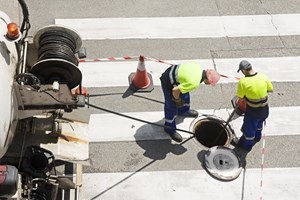Queens, New York Breaks Ground on $139 Million Upgrade Project
(QUEENS, New York) — A New York neighborhood has broken ground on a $139 million renovation across 25 blocks which will include, among other things, several miles of sewer and water infrastructure upgrades.
The New York City Economic Development Corporation (NYCEDC) is spearheading a massive community improvement project in Far Rockaway, New York, in Queens. The goal of the project is to revitalize the neighborhood by rebuilding as well as building new streets, adding sidewalks, sewer and water infrastructure upgrades, and developoing a 15,000 square foot pedestrian plaza.
Work on the project will be divided into two phases with the sewer and water upgrades included in Phase I. More than two miles of new storm sewers ranging in size from 12 inches in diameter up to 13.5 feet high by 4.5 feet wide will eventually be installed to improve local drainage. More than 120 new catch basins will be installed to capture storm water and direct it to the new storm sewers.
The project will also upgrade about 11,000 feet of existing sanitary sewers with new pipes ranging from 10 to 36 inches in diameter and replace about 10,000 feet of aging water mains with new pipes from 8 to 20 inches in diameter. At least 39 new fire hydrants will be installed to enhance local fire protection. Several private utility companies are also contributing to the project cost in order for the City’s contractor to relocate or upgrade their equipment in the area.
Several rain gardens will be installed throughout the project to help absorb stormwater in an effort to prevent overflow.
“This historic $139 million investment in Downtown Far Rockaway’s infrastructure is a critical component for the future success of our community,” said Council Member Donovan Richards. “These long overdue investments will bring new streetscapes, plaza space, green infrastructure and improved stormwater drainage that will ensure a more pedestrian friendly Far Rockaway that can better manage future storms.
Construction began in late September and is expected to take three years.
- Underground Construction
Related News
From Archive

- Glenfarne Alaska LNG targets late-2026 construction start for 807-mile pipeline project
- U.S. water reuse boom to fuel $47 billion in infrastructure spending through 2035
- $2.3 billion approved to construct 236-mile Texas-to-Gulf gas pipeline
- Major water pipe break in Puerto Rico hits over 165,000 customers
- Potomac River Tunnel project enters construction phase beneath Washington, D.C.
- Pennsylvania American Water launches interactive map to identify, replace lead water service lines
- Trump's tariffs drive $33 million cost increase for Cincinnati sewer project
- Utah city launches historic $70 million tunnel project using box jacking under active rail line
- Tulsa residents warned after sewer lines damaged by boring work
- Fatal trench collapse halts sewer construction in Massachusetts; two workers hospitalized




Comments